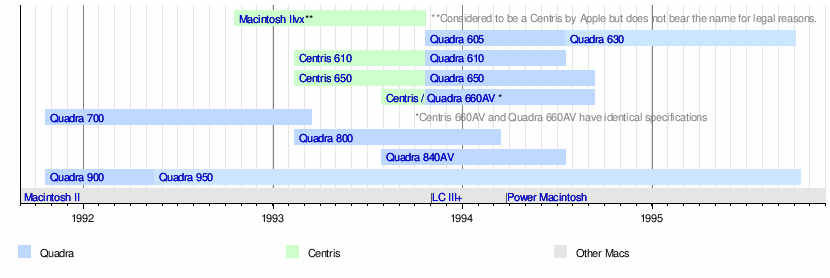Macintosh Quadra 650
The Macintosh Quadra 650, originally called the Macintosh Centris 650, is a personal computer designed, manufactured and sold by Apple Computer from February 1993 to September 1994. The Centris 650 was introduced alongside the smaller Centris 610 as the replacement for the Macintosh IIci, IIvi and Quadra 700, and it was intended as the start of the new midrange Centris line of computers.[2] Later in 1993, Apple decided to follow an emerging industry trend of naming product families for their target customers – Quadra for business, LC for education, and Performa for home – and folded the Centris 650 into the Quadra family.[3]
 A Macintosh Quadra 650 | |
| Also known as | "Speedbump 650"[1] |
|---|---|
| Developer | Apple Computer, Inc. |
| Product family | Macintosh Quadra |
| Release date | February 10, 1993 |
| Introductory price | US$2,699 (equivalent to $4,777 in 2019) |
| Discontinued | September 12, 1994 |
| Operating system | System 7.1 to OS 8.1 or with PowerPC Upgrade OS 9.1, A/UX |
| CPU | Motorola 68LC040 or 68040 @ 25 or 33 MHz |
| Memory | 4 or 8 MB onboard, expandable to 132 or 136 MB (80 ns 72-pin SIMM) |
| Dimensions | Height: 6 inches (15 cm) Weight: 13 inches (33 cm) Depth: 16.5 inches (42 cm) |
| Mass | 25 pounds (11 kg) |
| Predecessor | Macintosh IIci Macintosh IIvi Macintosh IIvx Macintosh Quadra 700 |
| Successor | Power Macintosh 7100 Power Macintosh 8100 |
| Related articles | Macintosh Quadra 610 |
The Quadra 650 was discontinued without a direct replacement in September 1994, although the recently introduced Power Macintosh 7100, which has the same IIvx form factor as the 650, had a similar target audience and was sold in the same price range.
Models

Standard equipment on all Centris 650 models includes onboard video (with VGA support via an adapter), 3 NuBus slots, a Processor Direct Slot, two ADB and two serial ports, and an external SCSI connector. There are four SIMM slots that support 4, 8, 16, and 32 MB SIMMs, allowing for a maximum of 132 or 136 MB of RAM depending on configuration. Ethernet-capable models have an AAUI port. System 7.1 was included as standard and is the minimum required version.[1]
Introduced February 10, 1993:
- Macintosh Centris 650:[4] Sold in five configurations:[2]
- 25MHz 68LC040, 4 MB RAM (onboard), 512 KB VRAM, 80 MB HDD, no Ethernet
- 25MHz 68040, 8 MB RAM (4 onboard + 4 MB SIMM), 512 KB VRAM, 80 MB HDD, Ethernet
- 25MHz 68040, 8 MB RAM (4 onboard + 4 MB SIMM), 512 KB VRAM, 230 MB HDD, Ethernet
- 25MHz 68040, 8 MB RAM (4 onboard + 4 MB SIMM), 1 MB VRAM, 230 MB HDD, Ethernet, AppleCD 300i and microphone
- 25MHz 68040, 24 MB RAM (4 onboard + 16 + 4 MB SIMMs), 1 MB VRAM, 500 MB HDD, Ethernet
Introduced October 21, 1993:
- Macintosh Quadra 650:[5] 33 MHz 68040.
Timeline of Macintosh Quadra and Centris models

References
- Pogue, David; Schorr, Joseph (1999). "Chapter 12: From 128K to Quadra: Mac to Mac". MacWorld Mac Secrets, 5th Edition. IDG Books. pp. 481-482. ISBN 0-7645-4040-8.
- Gruman, Galen (April 1993). "Centris 610 & 650 - Two new midrange performers replace the venerable Mac II line". MacWorld Magazine. pp. 106–113.
- Sieter, Charles (December 1993). "New 040 Macs - We sort out the complex new lineup". MacWorld Magazine. pp. 92–98.
- "Centris 650: Technical Specifications". Apple.
- "Macintosh Quadra 650: Technical Specifications". Apple.
External links
| Wikimedia Commons has media related to Macintosh Quadra 650. |
- Centris 650 and Quadra 650 at apple-history.com
- Centris 650 and Quadra 650 at Low End Mac
- Centris 650 and Quadra 650 at EveryMac.com